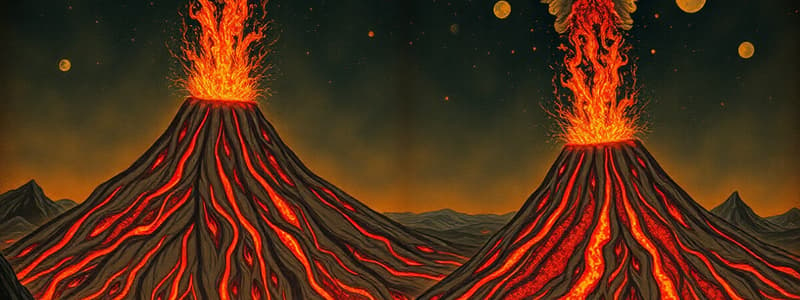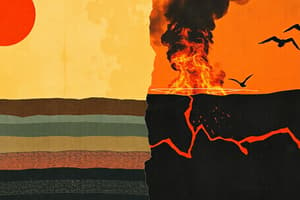Podcast
Questions and Answers
A volcano is best described as what?
A volcano is best described as what?
- A large deposit of cooled magma rocks with bubble patterns.
- An underground chamber filled with molten rock.
- The Roman god of fire and burning mountains.
- A vent in a planet's surface where molten rock escapes. (correct)
What is the key difference between magma and lava?
What is the key difference between magma and lava?
- Magma is the cooled form of lava after an eruption.
- Lava is a mixture of molten rock and ash, while magma is pure molten rock.
- Magma is molten rock beneath the surface, while lava is molten rock on the surface. (correct)
- Lava contains tephra, while magma does not.
Which of the following factors primarily determines the type of volcanic eruption?
Which of the following factors primarily determines the type of volcanic eruption?
- The atmospheric pressure of the planet or moon.
- The amount of tephra present in the surrounding area.
- The pressure within the magma chamber and the availability of vents. (correct)
- The depth and size of the magma chamber.
What is the composition of tephra ejected from a volcano?
What is the composition of tephra ejected from a volcano?
How do scientists use magma chambers to predict volcanic eruptions?
How do scientists use magma chambers to predict volcanic eruptions?
Flashcards
What is a volcano?
What is a volcano?
A vent in a planet or moon's crust where molten rock or steam escapes.
What is magma?
What is magma?
Molten rock under the Earth's crust.
What is lava?
What is lava?
Molten rock that has erupted onto the surface.
What is tephra?
What is tephra?
Signup and view all the flashcards
What is a magma chamber?
What is a magma chamber?
Signup and view all the flashcards
Study Notes
What is a Volcano?
- Volcanology is the study of volcanoes.
- A volcano is a vent in the Earth's (or another celestial body's) crust where molten rock or steam escapes.
- Volcanoes can be found underwater, on land, and under glaciers.
- Volcanoes have been identified on three planets, one dwarf planet, and four moons within the solar system.
- Most known volcanoes are currently inactive.
- The term "volcano" originates from the Italian "Vulcano" or French "Volcan," both meaning "burning mountain," derived from the Roman god of fire, "Vulcan".
Magma vs Lava
- Magma is molten rock located beneath the Earth's crust.
- Lava is magma that has reached the surface through a vent.
- Tephra includes rocks and debris ejected into the air during an eruption, including ground fragments, rocks mixed with magma, and ash from burning vegetation
Earth's Crust and Magma Chambers
- The Earth's crust is the planet's thin, outermost layer, accounting for only 1% of its total volume.
- Vents vary in shape and size based on eruption type and location, ranging from small holes to large craters.
- A magma chamber is an underground reservoir filled with magma.
- Vents are always located above magma chambers.
- Magma chambers near the surface aid scientists in predicting eruptions.
- The pressure within the magma chamber and the resistance of the surface determine the eruption style.
Types of Volcanoes
- There are four main types of volcanoes: cinder cones, composite volcanoes, shield volcanoes, and lava domes.
- Cinder Cones: simplest type, formed from ejected lava around a single vent. They feature violent eruptions and a circular or oval cone shape, typically with a crater.
- Composite Volcanoes: steep-sided, symmetrical cones composed of layers of lava flows and cinders, with a summit crater containing one or more vents.
- Shield Volcanoes: have a broad, rounded shape resembling a shield, formed by thin layers of fluid lava. Vents can be central or from fissures. They are among the largest volcanoes.
- Lava Domes: formed by smaller amounts of thick lava that cannot flow far, accumulating as it cools and hardens from the inside out.
Volcano Composition and Surrounding Land
- Thin flowing lava creates flatter volcanoes, while explosive eruptions and thick lava form taller volcanoes.
- Igneous rocks from volcanoes consist mainly of aluminum, calcium, iron, magnesium, oxygen, potassium, silicon, sodium, and titanium.
- Landforms around volcanoes are affected by past and present volcanic activity.
- Cooled lava rocks enhance plant growth due to their nutrient content and water retention capabilities.
Volcanic Activity
- Volcanic activity involves the release of hot gas, lava, or rocks through the Earth's surface (or other celestial bodies).
- Volcanic activity is not always dramatic; it can include slow lava flows over extended periods.
- It results from pressure buildup from rising magma and tectonic plate movement.
- The Pacific Ocean Basin, known as the "ring of fire," is a tectonically active region with a high concentration of volcanoes. Volcanoes also occur at hotspots within plates, often above magma chambers.
What is an Eruption?
- An eruption is a sudden, often violent, release of volcanic material.
- Initial eruptions create new vents and involve hot gas, lava, rocks, ash, and steam.
- Effusive eruptions: involve liquid magma, with pressure decreasing rapidly upon release. Although they can cause damage, they generally result in fewer fatalities.
- Explosive eruptions: are more violent, ejecting thick magma and rocks into the air. Blocked vents can lead to cyclical explosions of rocks, dust, gas, and debris.
- The eruption of Mount Nyiragongo in the Democratic Republic of the Congo in 2021 destroyed over 1,000 homes and resulted in 32 deaths.
- The 2018 eruption of Anak Krakatoa in Indonesia triggered a tsunami and landslide, causing over 400 deaths and 14,000 injuries. The volcano's height decreased by over 200 meters.
Hazards of Volcanic Eruptions
- The style of volcanic eruptions depends on pressure, vent size, and crust thickness.
- High magma fluidity and easily opened vents lead to slow lava flows.
- Thick magma and a thick crust with no readily available vents cause explosive eruptions.
- Hazards of volcanic eruptions include: gas clouds, acid rain, tephra, ash, lava flow, landslide, pyroclastic flow, tsunami, earthquake, and loss of plants and habitats.
Icelandic Volcanoes
- Iceland has over 130 volcanoes and is expanding each year.
- Iceland is located on the boundary between two diverging continental plates, where magma rises to fill the gap.
- One valley in Iceland expands more than 2 cm annually.
- Iceland, known as the "land of fire and ice," has active volcanoes under ice sheets.
Strombolian Volcanoes
- Strombolian eruptions are named after an island between Italy and Sicily, featuring small, frequent blasts.
- These eruptions involve short-lived bursts reaching up to one kilometer and lack a sustained column.
- The Paricutin volcano in Mexico began with thunder-like sounds and swelling ground, growing 424 meters tall in nine years through strombolian eruptions and lava flows.
Hawaiian Volcanoes
- The Hawaiian Islands formed over a hotspot in the middle of a tectonic plate through repeated eruptions.
- The movement of the tectonic plate over the stationary hotspot resulted in the formation of a series of islands.
- The growth pattern of the islands helps scientists track the plate's movement.
Peléan Volcanoes
- Pelean volcanoes are named after the 1902 eruption of Mount Pelée in Martinique, which caused over 30,000 fatalities.
- These eruptions involve large amounts of gas, dust, ash, and lava ejected from a central crater.
- The rapid descent of material at speeds over 150 km/hour makes them particularly dangerous, causing high death tolls and significant destruction.
Vulcanian Volcanoes
- Vulcanian eruptions, named after an eruption on the island of Vulcano, are moderately strong.
- Characterized by the ejection of a large solid plug, followed by continued eruption, sending magma 1-10 km high, often starting with a loud explosion.
Plinian Volcanoes
- Plinian volcanoes are named after Pliny the Younger, who documented the eruption of Mt. Vesuvius in 79 AD, which buried Pompeii and Herculaneum.
- Also referred to as Vesuvian volcanoes.
- These eruptions feature sustained columns, often reaching over 45 km in height.
Classification of Volcanoes
- Volcanoes are classified as active, dormant, or extinct.
- These classifications are loosely defined and may change.
Active Volcanoes
- Considered active if currently erupting or expected to erupt soon.
- There are approximately 1500 active volcanoes on Earth, with 50-70 erupting each year.
- The Yasur volcano in Vanuatu has been erupting continuously since July 1774.
Dormant Volcanoes
- Dormant volcanoes have erupted in recorded history and are expected to erupt again, but not soon.
- Prediction of eruptions is inexact.
- Mount St. Helens was dormant for over 100 years until its eruption in 1980.
- Some volcanoes have eruption cycles of 600 years or more.
Extinct Volcanoes
- Extinct volcanoes are those that scientists believe will not erupt again.
- Kohala in Hawaii is classified as extinct, with no eruptions in over 60,000 years.
- Volcanoes can undergo rejuvenation, reversing their extinct status.
Studying That Suits You
Use AI to generate personalized quizzes and flashcards to suit your learning preferences.




